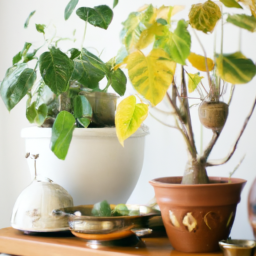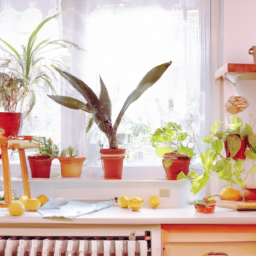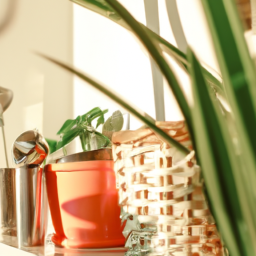
Are you looking to bring a touch of nature into your kitchen? Well, look no further! In this blog post, we will be diving into the world of indoor plants for your kitchen. Adding greenery to your cooking space not only enhances the aesthetics but also offers a myriad of benefits. From purifying the air to boosting your mood, indoor plants in the kitchen can truly transform the ambiance and make it a more inviting and refreshing place to be. So, let’s explore the wonderful world of indoor plants and discover which ones are perfect for your kitchen!
Benefits of Having Indoor Plants in Your Kitchen
Indoor plants not only add beauty to your kitchen but also offer numerous benefits that can enhance your overall well-being. Having a touch of nature indoors can create a calming and refreshing atmosphere while providing various health advantages. In this article, we will explore the many benefits of having indoor plants in your kitchen and how they can transform your cooking space into a vibrant and healthy environment.
Improved Air Quality
One of the primary benefits of having indoor plants in your kitchen is their ability to improve air quality. Plants naturally absorb carbon dioxide and release oxygen through photosynthesis, promoting a healthier environment for you and your family. Additionally, certain plants, such as snake plants and peace lilies, are known for their air-purifying properties, removing harmful toxins like formaldehyde and benzene from the air.
In the kitchen, where cooking activities can generate pollutants like smoke and odors, having indoor plants can help neutralize these unwanted elements. Plants act as natural air filters, improving the overall air quality and creating a fresher atmosphere for you to enjoy while preparing meals.
Furthermore, indoor plants release moisture through a process called transpiration, which can increase humidity levels in your kitchen. This can be particularly beneficial if you live in a dry climate or during the winter months when indoor heating can cause dry air. Adequate humidity levels can prevent respiratory issues, dry skin, and allergies, making your kitchen a more comfortable space to spend time in.
Stress Reduction and Improved Mental Health
Bringing nature indoors has been proven to reduce stress levels and improve mental health. The sight of greenery and the connection with nature can have a calming effect on our minds, helping to alleviate stress and anxiety. In the kitchen, where we often experience the pressures of meal preparation and daily routines, having indoor plants can create a soothing ambiance that promotes relaxation.
Studies have shown that being around plants can also enhance concentration and productivity. This can be especially beneficial in the kitchen, where focus and attention to detail are essential for cooking tasks. Having indoor plants nearby can help improve cognitive function and make your cooking experience more enjoyable and efficient.
Additionally, taking care of indoor plants can be a therapeutic activity in itself. Engaging in gardening tasks, such as watering, pruning, and repotting, can provide a sense of accomplishment and satisfaction. It offers a break from the fast-paced world and allows you to connect with nature on a personal level, promoting overall well-being.
Aesthetically Pleasing and Functional
Indoor plants can serve as beautiful decorative elements in your kitchen, adding a touch of color, texture, and life to the space. They can be displayed on countertops, shelves, or hanging from the ceiling, creating visually appealing focal points. The variety of plant shapes and sizes available allows you to choose plants that complement your kitchen’s style and aesthetics.
In addition to their visual appeal, indoor plants can also be functional in the kitchen. For example, herbs like basil, rosemary, and mint can be grown indoors and used fresh in your cooking. Having these herbs readily available not only adds flavor to your dishes but also saves you from buying packaged herbs from the store. It’s a sustainable and cost-effective way to enhance your culinary creations.
Moreover, some indoor plants, like aloe vera and spider plants, have medicinal properties. Aloe vera gel can be used to soothe minor burns and skin irritations, while spider plants are known for their air-purifying abilities. Having these plants in your kitchen ensures you have natural remedies within reach whenever the need arises.
In conclusion, incorporating indoor plants into your kitchen can bring numerous benefits to both your physical and mental well-being. From improving air quality and reducing stress to adding beauty and functionality, indoor plants have the power to transform your kitchen into a healthier and more vibrant space. So why not introduce some green companions into your cooking sanctuary and enjoy the many advantages they offer?

Best Indoor Plants for a Kitchen Environment
Having indoor plants in your kitchen not only adds a touch of natural beauty but also provides numerous benefits. From purifying the air to reducing stress levels, indoor plants can transform your kitchen into a vibrant and refreshing space. However, not all plants thrive in a kitchen environment due to varying light conditions and humidity levels. In this article, we will explore the best indoor plants that are well-suited for a kitchen setting.
1. Herbs
Herbs are not only great for cooking but also make excellent indoor plants for your kitchen. They thrive in the warm and humid conditions typically found in kitchens. Here are a few popular herbs that you can easily grow in your kitchen:
Basil: Basil is a versatile herb that adds a delightful aroma and flavor to your dishes. It requires bright, indirect light and regular watering to thrive. Place it near a sunny window or under a grow light for optimal growth.
Mint: Mint is known for its refreshing scent and is perfect for making herbal teas or adding flavor to desserts. It prefers bright, indirect light and well-draining soil. Keep the soil consistently moist but not waterlogged.
Parsley: Parsley is a popular herb used in various cuisines. It grows well in bright, indirect light and slightly moist soil. Regularly trim the leaves to encourage new growth and prevent the plant from becoming leggy.
Chives: Chives are easy to grow and have a mild onion flavor. They prefer bright, indirect light and well-draining soil. Water the plant when the top inch of soil feels dry.
Rosemary: Rosemary is a fragrant herb that adds a distinct flavor to dishes. It requires bright light and well-draining soil. Allow the soil to dry slightly between waterings.
Oregano: Oregano is a hardy herb that can tolerate a range of light conditions. It prefers well-draining soil and moderate watering. Place it in a spot that receives at least a few hours of direct sunlight each day.
2. Succulents
If you have limited space or prefer low-maintenance plants, succulents are an excellent choice for your kitchen. They are known for their ability to store water in their leaves, making them drought-tolerant and perfect for busy individuals. Here are a few popular succulents that thrive in a kitchen environment:
Aloe Vera: Aloe vera is not only a beautiful succulent but also has various medicinal properties. It requires bright, indirect light and well-draining soil. Allow the soil to dry out between waterings, as overwatering can cause root rot.
Jade Plant: Jade plants are known for their thick, fleshy leaves and tree-like appearance. They prefer bright, indirect light and well-draining soil. Water the plant when the top inch of soil feels dry.
Echeveria: Echeverias are stunning rosette-shaped succulents that come in a variety of colors. They require bright, indirect light and well-draining soil. Water the plant when the top inch of soil feels dry.
String of Pearls: The string of pearls is a unique succulent with cascading stems adorned with small, bead-like leaves. It thrives in bright, indirect light and well-draining soil. Allow the soil to dry out between waterings.
3. Spider Plant
The spider plant is a popular choice for kitchens due to its ability to purify the air and its low maintenance requirements. It has long, arching leaves with white stripes, giving it an attractive appearance. Spider plants prefer bright, indirect light but can tolerate lower light conditions as well. Water the plant when the top inch of soil feels dry, and mist the leaves occasionally to increase humidity.
In conclusion, adding indoor plants to your kitchen can enhance its aesthetic appeal and provide numerous benefits. Herbs like basil, mint, parsley, chives, rosemary, and oregano are great options for those who enjoy cooking. If you prefer low-maintenance plants, succulents like aloe vera, jade plant, echeveria, and string of pearls are ideal choices. The spider plant is another excellent option that purifies the air and requires minimal care. Choose plants that thrive in the light and humidity conditions of your kitchen, and enjoy the refreshing ambiance they bring to your culinary space.

Tips for Caring for Indoor Plants in the Kitchen
Indoor plants are a wonderful addition to any kitchen. They not only add a touch of greenery and beauty to the space, but they also provide numerous benefits such as improved air quality and a sense of tranquility. However, caring for indoor plants in the kitchen requires some specific considerations. In this article, we will discuss some essential tips to help you keep your indoor plants thriving and healthy in the kitchen environment.
1. Choose the Right Plants
When selecting indoor plants for your kitchen, it’s important to consider the specific conditions of the space. The kitchen typically has high humidity, fluctuating temperatures, and varying levels of natural light. Therefore, it’s crucial to choose plants that can thrive in these conditions.
Some excellent choices for kitchen plants include herbs like basil, mint, and rosemary, as they not only tolerate the kitchen environment but also provide fresh flavors for your culinary creations. Additionally, plants like spider plants, pothos, and peace lilies are known for their ability to purify the air, making them ideal choices for the kitchen.
Remember to consider the available space in your kitchen as well. If you have limited counter space, consider hanging plants or using vertical planters to maximize the use of space.
2. Provide Adequate Lighting
Proper lighting is crucial for the growth and development of indoor plants. In the kitchen, natural light may vary depending on the location of windows and the time of day. Therefore, it’s essential to assess the lighting conditions and supplement them if necessary.
If your kitchen receives limited natural light, consider using artificial grow lights. LED grow lights are a popular choice as they are energy-efficient and provide the right spectrum of light for plant growth. Place the lights close to the plants, ensuring they receive light for around 12-16 hours a day.
Rotate your plants regularly to ensure even exposure to light, as plants tend to grow towards the light source. This will help prevent lopsided growth and ensure all parts of the plant receive adequate light.
3. Monitor and Control Humidity
The kitchen is often a humid environment due to cooking activities like boiling water and steaming. While some plants thrive in high humidity, others may suffer from fungal diseases or root rot. It’s essential to monitor and control humidity levels to ensure the well-being of your indoor plants.
One way to control humidity is by using a dehumidifier. This device helps remove excess moisture from the air, creating a more suitable environment for your plants. Additionally, you can place a tray filled with water near your plants. As the water evaporates, it increases the humidity around the plants.
Regularly check the moisture levels in the soil and ensure proper drainage to prevent waterlogging. Avoid overwatering your plants, as this can lead to root rot. Allow the top inch of soil to dry out before watering again, and adjust the frequency based on the specific needs of your plants.
Furthermore, grouping plants together can create a microclimate with increased humidity, benefiting moisture-loving plants. However, ensure there is enough space between plants to prevent the spread of pests or diseases.
In conclusion, caring for indoor plants in the kitchen requires careful consideration of the specific conditions in this space. By choosing the right plants, providing adequate lighting, and monitoring humidity levels, you can create a thriving environment for your indoor plants. Remember to regularly inspect your plants for signs of pests or diseases and take appropriate action to maintain their health. With proper care, your indoor plants will not only enhance the aesthetics of your kitchen but also contribute to a healthier and more enjoyable cooking experience.
Highlights of this article
Indoor plants have been a popular trend in home décor for quite some time now, but have you ever considered bringing them into your kitchen? Not only do indoor plants add a touch of nature and beauty to your cooking space, but they also offer a range of benefits that can enhance your overall well-being. Whether you have a spacious kitchen or a tiny apartment galley, there are plenty of options to choose from when it comes to incorporating indoor plants into your culinary haven.
One of the main advantages of having indoor plants in your kitchen is their ability to purify the air. Plants naturally absorb carbon dioxide and release oxygen, improving the air quality in your home. In the kitchen, where cooking can produce smoke and odors, having plants like English ivy or peace lilies can help filter out harmful pollutants and freshen up the atmosphere. Additionally, certain herbs like basil, rosemary, and mint can be grown right on your kitchen countertop, allowing you to conveniently pluck fresh leaves whenever you need them for cooking. Not only will these herbs add flavor to your dishes, but they will also fill your kitchen with delightful aromas.
Top FAQs:
Q1: What are some popular indoor plants suitable for the kitchen?
A1: There are several popular indoor plants that thrive in kitchen environments. Some great options include herbs like basil, rosemary, and mint, which not only add a touch of greenery but also provide fresh flavors for your culinary creations. Other popular choices are spider plants, pothos, and peace lilies, which are known for their air-purifying qualities.
Q2: How do I care for indoor plants in my kitchen?
A2: Caring for indoor plants in the kitchen is relatively easy. Most indoor plants require adequate sunlight, so place them in a spot where they can receive indirect sunlight. Water the plants regularly, but be careful not to overwater them as this can lead to root rot. Additionally, make sure to provide proper drainage for your plants by using pots with drainage holes or adding a layer of gravel at the bottom.
Q3: Can indoor plants in the kitchen help improve air quality?
A3: Yes, indoor plants in the kitchen can help improve air quality. Many indoor plants have the ability to filter out toxins and release oxygen, thus improving the overall air quality in your kitchen. Plants like snake plants, spider plants, and peace lilies are known for their air-purifying properties and can help remove pollutants such as formaldehyde and benzene from the air.
Q4: Are there any indoor plants that are safe for pets in the kitchen?
A4: Yes, there are several indoor plants that are safe for pets in the kitchen. Some pet-friendly options include spider plants, Boston ferns, and areca palms. However, it’s always a good idea to double-check the toxicity of a specific plant before bringing it into your home, as some pets may have allergies or sensitivities to certain plants.
Q5: Can indoor plants in the kitchen attract pests?
A5: While it’s possible for indoor plants in the kitchen to attract pests, proper care and maintenance can help minimize this risk. Avoid overwatering your plants, as damp soil can attract gnats and other insects. Regularly inspect your plants for any signs of pests, such as webs or small insects, and take appropriate measures to address the issue, such as using organic pest control methods or isolating the affected plant from others.
Dr. Olivia Green is a botanist with over two decades of experience in indoor plant cultivation. She holds a Ph.D. in Plant Biology and has dedicated her career to researching plant behavior in controlled environments. Dr. Green is passionate about helping plant enthusiasts master the art of indoor gardening through her extensive knowledge and practical insights.


